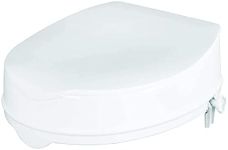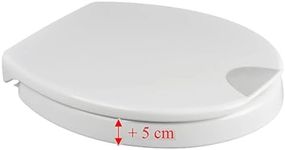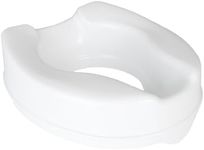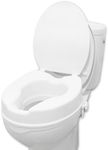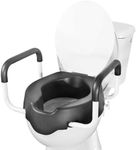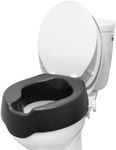Buying Guide for the Best Raised Toilet Seats
Choosing the right raised toilet seat can significantly enhance comfort and safety for individuals who have difficulty sitting down or standing up from a standard toilet. These seats are particularly beneficial for the elderly, those recovering from surgery, or individuals with mobility issues. When selecting a raised toilet seat, it's important to consider factors such as height, weight capacity, and additional features that can provide extra support and stability. Understanding these specifications will help you make an informed decision that best suits your needs or the needs of the person using it.HeightThe height of a raised toilet seat is crucial because it determines how much elevation is added to the existing toilet seat. This is important for reducing the distance the user needs to lower themselves, which can alleviate strain on the knees and hips. Raised toilet seats typically range from 2 to 6 inches in height. If the user has significant difficulty bending or has very limited mobility, a higher seat may be more appropriate. Conversely, if the user only needs a slight elevation, a lower height might suffice. Consider the user's specific mobility challenges when choosing the height.
Weight CapacityWeight capacity refers to the maximum weight the raised toilet seat can safely support. This is important to ensure the seat is stable and secure for the user. Most raised toilet seats have a weight capacity ranging from 250 to 400 pounds. It's essential to choose a seat that can comfortably support the user's weight to prevent accidents or damage to the seat. Always check the manufacturer's specifications to ensure the seat meets the necessary weight requirements.
Attachment MethodThe attachment method describes how the raised toilet seat is secured to the existing toilet. This is important for ensuring stability and safety during use. Common attachment methods include locking mechanisms, which provide a secure fit, and non-locking models, which are easier to remove but may not be as stable. If the user requires a more permanent solution, a locking mechanism is advisable. For those who need to frequently remove the seat, a non-locking model might be more convenient. Consider the user's need for stability versus ease of removal when selecting an attachment method.
ArmrestsArmrests provide additional support and stability, making it easier for users to sit down and stand up. This feature is particularly important for individuals with limited upper body strength or balance issues. Raised toilet seats with armrests can offer a sense of security and reduce the risk of falls. If the user struggles with balance or needs extra support, choosing a model with armrests is beneficial. However, if space is limited or the user does not require additional support, a model without armrests may be more suitable.
MaterialThe material of the raised toilet seat affects its durability, comfort, and ease of cleaning. Common materials include plastic and padded foam. Plastic seats are durable and easy to clean, making them a practical choice for many users. Padded foam seats offer additional comfort, which can be beneficial for users who spend extended periods on the toilet. Consider the user's comfort preferences and the ease of maintenance when selecting the material. If hygiene and ease of cleaning are priorities, a plastic seat may be preferable.


